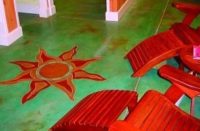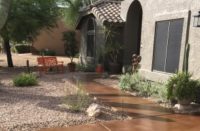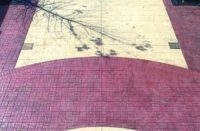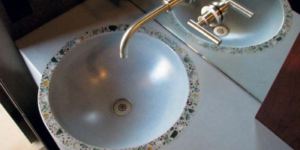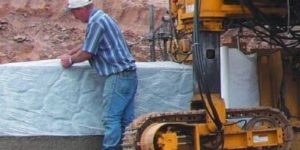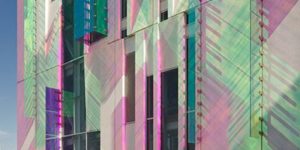What started as an idea to create decorative concrete walls with finer detail and less hassle led to the composite material – Arch-Crete Composite Forming System.
What contractor hasn’t approached a job with the thought that better equipment or improved techniques would make the project go more smoothly?
Hatem Hannawa and his brother Wally were tired of building concrete walls with aluminum or wooden forms, which they found cumbersome to work with, hard to maintain and unreliable. Five years ago, as a result of a form-liner requirement on a project, they started developing a new forming system. What started as an idea to create decorative concrete walls with finer detail and less hassle eventually led to a composite material that would perform the way they wanted it to.
 They were looking for a textured concrete forming system that would create deep imprints of up to 21⁄2 inches, not the 1⁄8 inch or so of relief left behind by the aluminum forms. They wanted a material that would resist the pressure of the concrete and release easily. They needed the material to be resistant to ultraviolet rays and freezing temperatures so it could be used in all parts of the country. And they wanted the material to be lightweight, long-lasting, easy to maintain and inexpensive to use.
They were looking for a textured concrete forming system that would create deep imprints of up to 21⁄2 inches, not the 1⁄8 inch or so of relief left behind by the aluminum forms. They wanted a material that would resist the pressure of the concrete and release easily. They needed the material to be resistant to ultraviolet rays and freezing temperatures so it could be used in all parts of the country. And they wanted the material to be lightweight, long-lasting, easy to maintain and inexpensive to use.
It was a tall order, but after innumerable formulations over more than three years, they found success. Arch-Crete Composite Forming System was born.
 Now Arch-Crete, a product of Michigan-based Architectural Concrete Creations, can boast that its 3-foot by 6-foot panels weigh only 57 pounds versus a combination of form and urethane liner, which can weigh as much as 150 pounds. No cranes are needed on the job site, and the panels can be hand-set.
Now Arch-Crete, a product of Michigan-based Architectural Concrete Creations, can boast that its 3-foot by 6-foot panels weigh only 57 pounds versus a combination of form and urethane liner, which can weigh as much as 150 pounds. No cranes are needed on the job site, and the panels can be hand-set.
Arch-Crete calls its panels “unitized,” meaning they consist of an integrated structural grid with a textured face that was contoured using natural stones. The grid acts as reinforcement while the concrete is being poured.
 “Every feature that you find in a rock is on this mold,” Hatem Hannawa says. “Even if you walk up real close to it, and touch that rock, it feels real.” Some form liners can reproduce the shape of local stones, but they look shiny and feel too smooth; that’s not the case with Arch-Crete. “With every pour we can get a lot of detail,” he says. The six textures available are River Rock, Castle Cut, Cobble Stone, Ledge Stone, Boulder Stone and Flat.
“Every feature that you find in a rock is on this mold,” Hatem Hannawa says. “Even if you walk up real close to it, and touch that rock, it feels real.” Some form liners can reproduce the shape of local stones, but they look shiny and feel too smooth; that’s not the case with Arch-Crete. “With every pour we can get a lot of detail,” he says. The six textures available are River Rock, Castle Cut, Cobble Stone, Ledge Stone, Boulder Stone and Flat.
Other benefits? The system’s applied cost is less than 2 cents per square foot; concrete, colorants and other additives don’t stick to the panels; maintenance requires merely a power washer; and the panels can be used at least 1,500 times.
 Developers are finding more and more uses for the company’s products, Hannawa says. They can put up a barrier wall, a frequent requirement in residential projects, and make it decorative for less money than it would cost them to hire a mason. “The system doesn’t require skilled labor,” Hannawa says. “The form itself does everything because the concrete fills in the cracks, and it flows very nicely.” It takes only 10 minutes to figure out the installation process, he says. Stronger, more stable fasteners were developed that are easy to use as well.
Developers are finding more and more uses for the company’s products, Hannawa says. They can put up a barrier wall, a frequent requirement in residential projects, and make it decorative for less money than it would cost them to hire a mason. “The system doesn’t require skilled labor,” Hannawa says. “The form itself does everything because the concrete fills in the cracks, and it flows very nicely.” It takes only 10 minutes to figure out the installation process, he says. Stronger, more stable fasteners were developed that are easy to use as well.
Hannawa recalls one project in which a 9-foot-high wall was needed to block the view of an industrial site from neighboring residents. Instead of building a flat wall, a four-man crew took just 23 days to cover 1,100 feet with a wall that resembled local stonework. The residents loved it.
 One contractor used the forms to make bases for light poles at a nearby Moose Lodge. Others are using the flexible, plastic forms to create pillars, garden fences, mailbox bases, planters and walls that wrap around 90-degree or 45-degree angles. “Not too many systems offer the ability to wrap around the inside or outside corners,” Hannawa says. “Arch-Crete allows you to be more creative.”
One contractor used the forms to make bases for light poles at a nearby Moose Lodge. Others are using the flexible, plastic forms to create pillars, garden fences, mailbox bases, planters and walls that wrap around 90-degree or 45-degree angles. “Not too many systems offer the ability to wrap around the inside or outside corners,” Hannawa says. “Arch-Crete allows you to be more creative.”
The landscaping and fencing applications are a small part of Arch-Crete’s market. Other projects include a 12-foot-high cobblestone wall for a parking structure, decorative foundations on residential homes and commercial buildings, a curving streetscape in Bend, Ore., various privacy-screen walls in Michigan and Wisconsin, and more.
 The Arch-Crete principals see the potential for even more creativity and growth for the business. Their immediate goal is to create seamless panels, which they plan to unveil at the 2006 World of Concrete. (Arch-Crete won a Most Innovative Product award at the 2004 World of Concrete.) The company also is developing three new textures, and plans to target the road-building and multistory commercial markets more heavily.
The Arch-Crete principals see the potential for even more creativity and growth for the business. Their immediate goal is to create seamless panels, which they plan to unveil at the 2006 World of Concrete. (Arch-Crete won a Most Innovative Product award at the 2004 World of Concrete.) The company also is developing three new textures, and plans to target the road-building and multistory commercial markets more heavily.
Hannawa says developing the product was a roller-coaster ride, with the inevitable ups and downs of successes and failures that comes with experimentation. “The satisfaction is at the end when you see all your hard work is paying off and it’s finally working,” he says. “Today we have a system that works perfectly, and it puts a lot of smiles on a lot of people’s faces — not just the contractors, but the end users who get to see something nice.”
